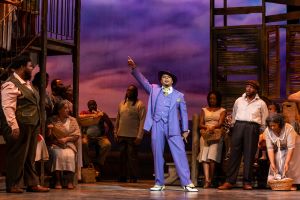Anyone reading this will most likely remember news footage of devastating floods throughout the Midwest during the spring and summer of both 2010 and 1993. As disruptive and destructive as those were to millions of Americans, they did not transform American culture like the great Mississippi River flood of 1927. So great was the force of this catastrophe that in places water volume per second exceeded that of Niagara Falls, and just south of Memphis the width of the Mississippi grew to sixty miles. In the aftermath of the destruction, poor sharecroppers had little, if anything, to which to return. Combine that with the forced conscription (i.e. 20th century slavery) that thousands of African-Americans were subjected to and you get the beginning of the great migration to Northern cities, especially Chicago.
It is this story, along with the availability of source footage from the Fox Movietone Newsreel Archive and the National Archives, that filmmaker Bill Morrison brings us The Great Flood. Duke Performances, in yet another coup of eclectic, multi-discipline presentations, followed up the previous night’s premiere at Carnegie Hall in New York with a nearly packed house at Duke University’s Reynolds Auditorium. Add to the mix the presence of the mind-boggling prolific guitarist Bill Frisell, as both composer and performer, and a quartet of consummate musicians, and you have an artistic event that is unique and emotional.
The combination of live music and movies is nothing new. In fact it is probably the oldest partnership going back to the dawn of movies when nearly every movie house had at least a resident pianist – or organist in the more upscale theaters – to accompany the silent films. Everything old becomes new again as this set up is now experienced as fresh and exciting.
It was announced that Morrison was not attending this performance as he was running in the New York Marathon the next morning. The quartet in place, they began with a haunting interpretation of the intro to Jerome Kern’s “Ol’ Man River” as the film depicts a map of the affected areas. The film footage was all contained on nitrate stock, a highly volatile material prone to decay and distortion. The fascinating aspect of this film is that rather than seeing this as an impediment to the film, Morrison uses the deterioration as sort of a character in the story. However, a great deal of the film is also quite sharp and clear.
The film is broken down into about seven or eight sections, each introduced on a simple black screen with titles like “tributaries,” “migration” and even “politicians.” In order to break the grimness of images of unimaginable poverty, devastation and people and animals trapped on rooftops, Morrison gives us a kind of halftime respite titled “Sears-Roebuck 1927 Catalogue,” in which we get a rapid-fire view of exactly that, while the quartet breaks into what is the first up-tempo playing in a kind of roaring twenties “everything is fine” attitude.
The quartet consisted of Frisell, guitar, Tony Scherr, bass and guitar, Ron Miles, trumpet, and Kenny Wollesen, drums and vibes. Frisell composed and arranged all of the music for this nearly 80-minute film, and it was his usual superb mix of blues, country and jazz, all in a uniquely understated yet commanding presence. Trumpeter Miles (very appropriate last name) was incredible, especially with his use of growls to illustrate the pain and suffering of those who lost everything. Frisell used the vibes, played by Wollesen, as a quasi dreamlike effect. It should also be noted that sound engineer Claudia Engelhart gave us an acoustic environment that could not have been better. Each instrument was clear, distinct and loud, but never piercing or completely overshadowing the film.
It was interesting to see the images of the migration, including views of a very impoverished city street in Chicago, as if to ask if life really would be better up North. Part of the premise of the film, backed by historical, demographic data, is that many of the displaced persons consisted of musicians that would influence and inspire generations of blues and rock artists. As homage to these artists, the final section of the film shows mesmerizing archival footage of great African-American musicians, some known, but most obscure, playing with unabashed joy: this was indeed images of the actual source of all blues-based music. While this was on screen, the quartet, in a quasi recap, played the dreamlike strains of the intro to “Ol’ Man River.” But this time, as if to proclaim that the river has harmed but not defeated us, they proceeded to the body of the song in an achingly beautiful rendition, slowed down to nearly a crawl. After a standing ovation, the quartet ended the gig without any encore, so we left with the words “he just keeps rolling along” in our mind. What else can we do?
Note: On 11/8, at noon, in Bone Hall, in the Biddle Music Building, Bill Morrison will speak on fllm/music collaboration – free.












